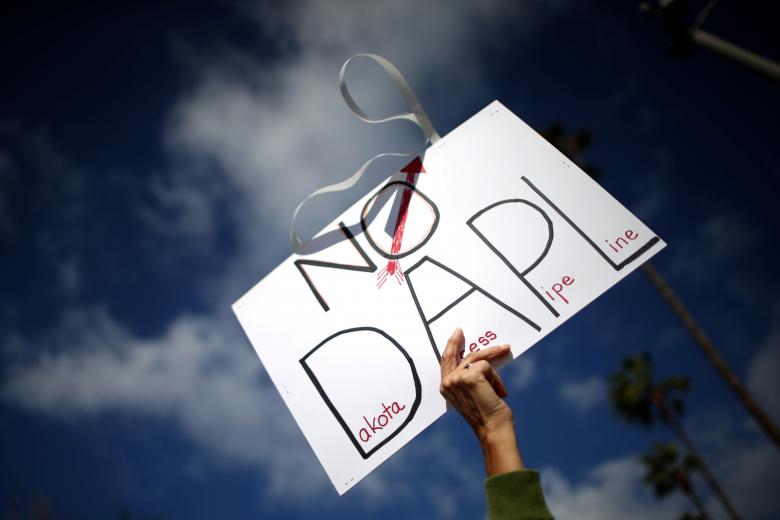White House seeks improved tribal relations as pipeline fight lingers

The leaders of hundreds of Native American tribes will meet with President Barack Obama at his eighth and final Tribal Nations Conference at the White House next week, while thousands of activists are encamped on the North Dakota prairie protesting a $3.7 billion oil pipeline.
The conference, designed to improve the relationship between Washington and the tribes, offers the last chance for this administration to hear from tribal leaders about the shortcomings of the current consultation system, which has been a source of conflict over the pipeline and other projects.
Federal agencies take different approaches to consulting with the tribes.
The North Dakota encampment represents the largest Native American protest in decades.
Along with environmentalists, the tribes say the 1,100-mile (1,886-km) Dakota Access pipeline, being developed by Energy Transfer Partners LP, would threaten the water supply and sacred sites of the Standing Rock Sioux.
The administration stepped in unexpectedly on Sept. 9 to temporarily block construction of the pipeline and called for “a serious discussion” about how the tribes are consulted by the government in decisions on major infrastructure projects.
“There are going to be hundreds of tribes interested in this consultation process. It will not be easy logistically, politically or substantively,” said Gabe Galanda, an attorney in Seattle who represents tribal governments.
VARYING APPROACHES
At present, the Army Corps of Engineers, which manages many infrastructure projects for the government, takes one approach to consulting Native American tribes. The Interior Department and its Bureau of Indian Affairs take another. Laws overlap.
The result can be confusion and sometimes anger, as with Dakota Access, said Bryan Newland, a lawyer and former adviser to the assistant secretary for Indian Affairs at the Interior Department until 2012.
A goal of the upcoming discussions will likely be simply to clarify what is meant by “consultation.”
The Interior Department and Bureau of Indian Affairs tend to hold face-to-face bilateral meetings with tribal leaders. The Corps often is accused of “checking marks on a checklist and moving on with what the developer intends to do,” said Galanda.
Ron His Horse is Thunder, spokesman for the Standing Rock Sioux, said: “There’s an issue between what the Corps believes is consultation and what the tribe believes is consultation.”
Before the Dakota Access protest erupted, tribe members voiced specific concerns with the government about the proximity of the pipeline to sacred burial sites, but these concerns were ignored, according to His Horse is Thunder.
But Amy Gaskill, public affairs chief for the Corps’ northwest division, said the tribe canceled several scheduled meetings. This was documented in a judge’s decision to reject the tribe’s request for an injunction, she said.
“We redoubled our efforts to work with the tribe to make sure their voice was heard in the process,” Gaskill said.
Energy Transfer Partners said last week it remained committed to the pipeline project, which had been slated to begin carrying oil south from the Bakken shale field by the end of 2016.
Sixteen years ago, President Bill Clinton issued an executive order requiring agencies to consult with Native Americans on matters affecting them. Obama in 2009 issued a memo intended to strengthen consultations with the tribes.
But doing that requires constant attention, said David Hayes, a former deputy secretary of the Interior under Clinton and Obama. “It is the kind of thing that requires diligence in terms of federal officials ensuring they are not simply treating tribes like any other stakeholder,” Hayes said.
Some agencies do not treat the tribes as sovereign nations, as they should under law, said Wizipan Garriott Little Elk, a former Department of Interior official.
“So often you see the agency request the consultation with the president of a tribal nation, but the agency will send a low-level bureaucrat to the meeting and simply check off the consultation box,” Garriott said.
The Corps also weighs a narrower geographic scope for projects than other agencies, so it can overlook impacts outside the immediate range of a reservation, Newland said.
Talks between tribal leaders and the administration are likely to expose a consultation system that makes tribes feel disadvantaged, said Emily Mallen, a lawyer with Van Ness Feldman specializing in pipelines.
“It is unknown how the federal government might seek to resolve this issue. The only thing that is sure is that the tribal consultation process will likely see significant changes as a result,” she said.




